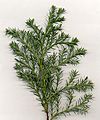Chamaecyparis pisifera
| Chamaecyparis pisifera | |
|---|---|
 | |
| Chamaecyparis pisifera Morton Arboretum acc. 745-27*4 | |
Conservation status | |
| Scientific classification | |
| Kingdom: | Plantae |
| Clade: | Tracheophytes |
| Clade: | Gymnospermae |
| Division: | Pinophyta |
| Class: | Pinopsida |
| Order: | Cupressales |
| Family: | Cupressaceae |
| Genus: | Chamaecyparis |
| Species: | C. pisifera |
| Binomial name | |
| Chamaecyparis pisifera (Siebold & Zucc.) Endl. | |
Chamaecyparis pisifera (Sawara cypress or Sawara Japanese: サワラ, romanized: Sawara) is a species of false cypress, native to central and southern Japan, on the islands of Honshū and Kyūshū.[2][1]
Description
It is a slow-growing coniferous tree growing to 35–50 m tall with a trunk up to 2 m in diameter. The bark is red-brown, vertically fissured and with a stringy texture. The foliage is arranged in flat sprays; adult leaves are scale-like, 1.5–2 mm long, with pointed tips (unlike the blunt tips of the leaves of the related Chamaecyparis obtusa (hinoki cypress), green above, green below with a white stomatal band at the base of each scale-leaf; they are arranged in opposite decussate pairs on the shoots. The juvenile leaves, found on young seedlings, are needle-like, 4–8 mm long, soft and glaucous bluish-green. The cones are globose, 4–8 mm diameter, with 6–10 scales arranged in opposite pairs, maturing in autumn about 7–8 months after pollination.[2]
Related species
A related cypress found on Taiwan, Chamaecyparis formosensis (Formosan cypress), differs in longer ovoid cones 6–10 mm long with 10–16 scales.[2] The extinct Eocene species Chamaecyparis eureka, known from fossils found on Axel Heiberg Island in Canada, is noted to be very similar to C. pisifera.[3]
Name
The Latin specific epithet pisifera, "pea-bearing", refers to the small round green cones.[4]
Uses
Timber
It is grown for its timber in Japan, where it is used as a material for building palaces, temples, shrines and baths, and making coffins, though less valued than the timber of C. obtusa. The wood is lemon-scented and light-colored with a rich, straight grain, and is rot resistant.[5]
Ornamental
It is also a popular ornamental tree in parks and gardens, both in Japan and elsewhere in temperate climates including western Europe and parts of North America. A large number of cultivars have been selected for garden planting, including dwarf forms, forms with yellow or blue-green leaves, and forms retaining the juvenile needle-like foliage; particularly popular juvenile foliage cultivars include 'Plumosa', 'Squarrosa' and 'Boulevard'.[5]
In cultivation in the UK the following have gained the Royal Horticultural Society's Award of Garden Merit[6] (confirmed 2017):[7]
- 'Boulevard':[8] 8 m (26 ft), blue-green foliage
- 'Filifera Aurea':[9] rounded, needle-like golden foliage, to 12 m (39 ft)
- 'Plumosa Compressa':[10] dwarf to 90 cm (35 in), soft mossy foliage on young plants
- 'Sungold':[11] rounded shrub to 3 m (9.8 ft) tall and wide, with needle-like lime green foliage
-
 Grove of 80-year-old trees
Grove of 80-year-old trees -
 Foliage and cones
Foliage and cones -
 Central trunk of a tree
Central trunk of a tree -
 Bark
Bark -
 Path in the Togakushi Shrine lined with C. pisifera
Path in the Togakushi Shrine lined with C. pisifera
- Bonsai example
-
 Foliage of the juvenile cultivar 'Boulevard', with soft feathery needle-like leaves
Foliage of the juvenile cultivar 'Boulevard', with soft feathery needle-like leaves - Cultivar 'Golden Charm'
-
 Cultivar 'Filifera aurea'
Cultivar 'Filifera aurea' -
 Leaves of the Filifera aurea
Leaves of the Filifera aurea -
 Cultivar 'Sungold'
Cultivar 'Sungold'
References
- ^ a b Farjon, A. (2013). "Chamaecyparis pisifera". IUCN Red List of Threatened Species. 2013: e.T42213A2962099. doi:10.2305/IUCN.UK.2013-1.RLTS.T42213A2962099.en. Retrieved 11 November 2021.
- ^ a b c Farjon, A. (2005). Monograph of Cupressaceae and Sciadopitys. Royal Botanic Gardens, Kew. ISBN 1-84246-068-4
- ^ Kotyk, M.E.A.; Basinger, J.F.; McIlver, E.E. (2003). "Early Tertiary Chamaecyparis Spach from Axel Heiberg Island, Canadian High Arctic". Canadian Journal of Botany. 81 (2): 113–130. doi:10.1139/B03-007.
- ^ Harrison, Lorraine (2012). RHS Latin for Gardeners. United Kingdom: Mitchell Beazley. ISBN 978-1845337315.
- ^ a b Dallimore, W., & Jackson, A. B. (1966). A Handbook of Coniferae and Ginkgoaceae 4th ed. Arnold.
- ^ "RHS Plantfinder -".
{{cite web}}: Missing or empty|url=(help) - ^ "AGM Plants - Ornamental" (PDF). Royal Horticultural Society. July 2017. p. 16. Retrieved 24 January 2018.
- ^ "RHS Plantfinder - Chamaecyparis pisifera 'Boulevard'". Retrieved 30 January 2018.
- ^ "RHS Plantfinder - Chamaecyparis pisifera 'Filifera Aurea'". Retrieved 30 January 2018.
- ^ "RHS Plantfinder - Chamaecyparis pisifera 'Plumosa Compressa'". Retrieved 30 January 2018.
- ^ "RHS Plantfinder - Chamaecyparis pisifera 'Sungold'". Retrieved 30 January 2018.
External links

- Conifers Around the World: Chamaecyparis pisifera - sawara cypress.
- v
- t
- e
| Athrotaxis |
|
|---|
| Actinostrobus |
|
|---|---|
| Austrocedrus |
|
| Callitris |
|
| Diselma |
|
| Fitzroya |
|
| Libocedrus |
|
| Neocallitropsis |
|
| Papuacedrus |
|
| Pilgerodendron |
|
| Widdringtonia |
|
| Cunninghamia |
|
|---|
| Callitropsis |
| ||||
|---|---|---|---|---|---|
| Calocedrus |
| ||||
| Chamaecyparis |
| ||||
| Cupressus |
| ||||
| Hesperocyparis |
| ||||
| Fokienia |
| ||||
| Juniperus |
| ||||
| Microbiota | |||||
| Platycladus |
| ||||
| Tetraclinis |
| ||||
| Thuja |
| ||||
| Thujopsis |
| ||||
| Xanthocyparis |
|
| Metasequoia |
|
|---|---|
| Sequoia |
|
| Sequoiadendron |
|
| Taiwania |
|
|---|
| Cryptomeria |
|
|---|---|
| Glyptostrobus |
|
| Taxodium |
|






















